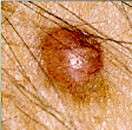Teledermatology implications for incidental skin CA detection

(HealthDay)—An in-person skin examination is important for detection of incidentally-identified skin malignancies, according to a review published in the April issue of the Journal of the American Academy of Dermatology.
Jaime L. Kingsley-Loso, from the University of Minnesota Medical School in Minneapolis, and colleagues retrospectively reviewed the medical charts of all dermatology consults at the Minneapolis Department of Veterans Affairs Medical Center over 8.25 years.
Of the 17,174 included consults; the researchers found that 2,257 patients (13.1 percent) had one or more biopsied incidental lesions. Of the 3,328 biopsied incidental lesions, half were malignant (this included 1,187 patients). For an incidental malignant lesion, the per-person detection rate was 6.9 percent. In 84 patients there were 87 incidental melanomas identified (a per-person detection rate of 0.5 percent). For biopsied incidental malignancies, the most frequent anatomical location was the head and neck (53.9 percent), with incidental melanomas most frequently located on the back (33.3 percent).
"An in-person skin examination by a trained dermatologist is important for detection of skin malignancies," the authors write. "This may have implications for teledermatology."
More information:
Abstract
Full Text (subscription or payment may be required)
Copyright © 2015 HealthDay. All rights reserved.

















